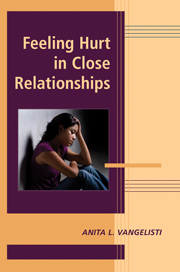Book contents
- Frontmatter
- Contents
- List of Contributors
- Foreword
- PART I INTRODUCTION
- PART II CONCEPTUALIZING HURT
- PART III HURTFUL ACTS
- PART IV HURT IN RELATIONAL CONTEXTS
- 12 Aggression and Victimization in Children's Peer Groups: A Relationship Perspective
- 13 Haven in a Heartless World? Hurt Feelings in the Family
- 14 Hurt Feelings in Adult Friendships
- 15 When Love Hurts: Understanding Hurtful Events in Couple Relationships
- 16 Hurt in Postdivorce Relationships
- PART V HURT IN APPLIED CONTEXTS
- Author Index
- Subject Index
- References
12 - Aggression and Victimization in Children's Peer Groups: A Relationship Perspective
from PART IV - HURT IN RELATIONAL CONTEXTS
Published online by Cambridge University Press: 04 August 2010
- Frontmatter
- Contents
- List of Contributors
- Foreword
- PART I INTRODUCTION
- PART II CONCEPTUALIZING HURT
- PART III HURTFUL ACTS
- PART IV HURT IN RELATIONAL CONTEXTS
- 12 Aggression and Victimization in Children's Peer Groups: A Relationship Perspective
- 13 Haven in a Heartless World? Hurt Feelings in the Family
- 14 Hurt Feelings in Adult Friendships
- 15 When Love Hurts: Understanding Hurtful Events in Couple Relationships
- 16 Hurt in Postdivorce Relationships
- PART V HURT IN APPLIED CONTEXTS
- Author Index
- Subject Index
- References
Summary
Children's peer relations play an important role in their psychological, academic, and social development. Although peers offer many positive benefits, such as friendships and opportunities to enact and receive prosocial behavior, on occasion, they are the source of harmful influences that result in immediate hurt feelings as well as short- and long-term negative consequences. One of the more salient aspects of peer relations is the occurrence of aggression. Immediate consequences of this aggression include fear, sadness, humiliation, and diminished self-concept for the victim; in contrast, the aggressors often experience immediate positive affect (happiness, feeling powerful) from the aggression itself or the rewards it brings. This does not imply that the hurtfulness of childhood aggression is one-sided, however. Moving beyond the immediate affect in aggressive encounters, we next review evidence that these acts of aggression have negative psychological, academic, and social consequences for both the aggressors and victims. Consistent with the theme of this book, we then turn our focus to the dyadic relationships between aggressors and victims. In this chapter we describe the conceptual, empirical, and theoretical support for this relationship perspective and then review research showing that certain aggressor–victim relationships are especially hurtful. Given that this relationship approach to studying aggression is relatively novel, we conclude with a discussion of its opportunities and challenges and a call for future research.
- Type
- Chapter
- Information
- Feeling Hurt in Close Relationships , pp. 235 - 259Publisher: Cambridge University PressPrint publication year: 2009
References
- 2
- Cited by



